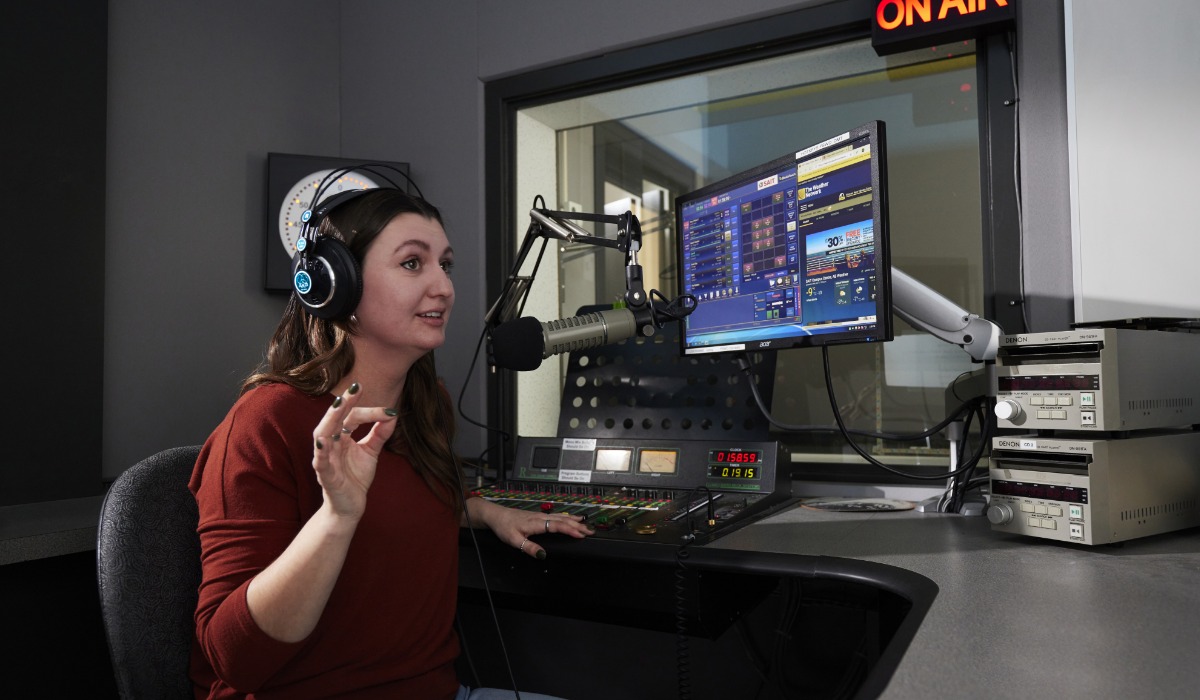Overview
Are you interested in journalism and the art of storytelling? If writing and digital media are your style, the Print and Online Journalism major is a great choice.
You'll learn the basics of journalism, including ethical news reporting, and then branch out in various areas, including marketing, public relations, and social media or digital content creation.
In the first year, you'll dive into news writing, basic photography, marketing, advertising, public relations, publication design, and online journalism. You'll build a solid foundation in journalism skills, preparing you for various career opportunities in digital media, public relations, communications, traditional journalism and more.
In your second year, you'll refine your writing, editing, layout design, and digital publishing skills. You'll work on various writing formats, from news features to blogs, and gain experience in editing, business writing, copywriting, and public relations. The program culminates in a simulated "newsroom" experience where you'll create content for SAIT's online newspaper.
This field offers the flexibility to blaze your path, whether as a freelance writer or photographer or working for a company or a news organization.
Our class sizes are small, with 32 students on average, and photography class sizes are capped at 16.
Whether you're passionate about writing, photography, or digital media, our Journalism program is your first step toward a rewarding career in storytelling, communication and the creative industries.
See our student's work
In this program, you'll have the opportunity to write for The Press, our online newspaper, covering a diverse array of subjects such as campus life, health and wellness, entertainment, and local city news. This will give you a platform to engage with a broad readership and hone your journalistic skills across multiple topics.
Those in journalism or creative industries tend to be innovative, methodical, and directive.
You need:
- flexibility
- eloquence and precise language skills
- an understanding of your medium and knowledge of your area of interest
- the ability to be objective and self-critical about your work and to accept objective criticism from others
- research and organizational skills
- time-management skills
- negotiation and marketing skills
- interviewing skills
- self-discipline.
You should enjoy gathering and clarifying information, writing, and presenting to people. You should also be prepared to work irregular hours and travel for work.
In your final semester, you'll participate in a four-week practicum at a digital or print-based journalism, editorial, corporate or non-profit organization.
You are responsible for securing your placement, which needs to be approved. Before your practicum, you'll complete assignments and get assistance creating a resume, setting up your LinkedIn profile, practicing interviews, and learning how to approach potential employers about a practicum placement.
You'll also have the option to complete a cooperative work term between your first and second year of study. This work term isn't required to graduate.
After successfully completing this program, you'll receive a SAIT Journalism diploma with a major in Print and Online Journalism.
Careers and opportunities
Each year, SAIT conducts a survey between February and April to determine the employment rate, salary and satisfaction of our newest SAIT alumni.
![]() 89% graduate employment rate
89% graduate employment rate
Find out more about our graduate employment statistics >
Our graduates may work in the following occupations. Some careers require additional experience and education.
Associated National Occupational Classification (NOC) codes: 51110, 51111, 51112, 51113, 53110.
Career planning support
Unsure which career path is for you? Here are some recommended career planning resources to help you decide your future.
You can also head to Alberta alis for lots of information about careers in Alberta, including quizzes and labour market information to help you narrow down a path.
Finally, you can take our online career finder quiz, which can help narrow your options based on your current skills and interests.
Courses
The Journalism - Print and Online Journalism diploma requires 60 credits (18 courses) to complete.
The program spans two years, with two semesters each year.
You must take all of the following courses to complete this program.
Journalism core
| Course | Credits |
|---|---|
|
In today's rapidly evolving media landscape, social media has become an indispensable tool for journalists to disseminate news, engage with audiences, and cultivate a digital presence. This comprehensive course on Social Media Management in Journalism is designed to equip aspiring and practicing journalists with the essential skills and strategies needed to navigate the dynamic intersection of journalism and social media. |
3 |
|
Building on the basics in Writing for Journalism, students will develop news and feature stories from different settings, and on different topics. The theory and practice of long-form feature writing will also be introduced. Pre-requisites:
|
3 |
|
This foundation course will examine the tools used to tell journalistic stories online. The focus will be on contemporary content management technology used by newspapers to present photos, written stories, video, and rich content to a global audience. |
3 |
|
Journalists are required to make decisions regularly about whom to talk to and use as sources, what information is appropriate to publish and what is not, and how to balance the competing demands of public versus private interests. Challenges related to the public sense of biases in news content, including AI-generated content, is an ongoing concern. The purpose of this course is to introduce students to the practice of ethical decision-making in journalism. Topics that will be introduced include sourcing practices and issues of personal privacy, the Truth and Reconciliation Commission's Call to Action #86, manipulation by, and of, the media, censorship and self-censorship, artificial intelligence, coverage of libel and slander laws in Canada and the right to be forgotten. |
3 |
|
Marketing Essentials is an introductory course offering you a solid foundation in marketing principles. Working individually and in teams, you will research and discover how marketing decisions are made and identify the components of sustainable marketing programs. Your research, content application and teamwork skills will be developed and reinforced as you progress through the course. Equivalents:
|
3 |
|
This introductory level course explores the technical fundamentals of digital photography as it relates to print and online news media. Learners will develop competency in proper camera handling, image acquisition, and computer workflow techniques. |
3 |
|
Building further on the technical concepts previously introduced in the program, this course focuses on the use of the photographic medium in journalistic storytelling. Through the use of still images and text, learners will discover the importance of visual communication in today's multiplatform media industry. Pre-requisites:
|
3 |
|
The basic concepts in creation of graphic elements will be the main topic of this course. The design, production and editing of info graphics for print page layouts and online will be covered. The course will also introduce learners to the planning and organization of print publications such as magazines and newspapers. |
3 |
|
News stories must be researched before they can be written. In this course, students will learn how to develop information for stories, with an emphasis on interviewing and online information gathering. Specific research sources, including governments and experts, also will be covered. |
3 |
|
Writing for Journalism, is an introduction to writing in news style for beginning journalists. Identification of newsworthy information, basic news story elements, clear writing structure, strong use of grammar, and other journalism writing techniques will be covered. |
3 |
Print and Online major
| Course | Credits |
|---|---|
|
In this course students will develop their online skills by researching, gathering, and publishing journalistic content for online delivery. Students will learn to identify the best (or most appropriate) platform by which to distribute the content. Pre-requisites:
|
3 |
|
Students in this course will continue building their writing skills and broadening their writing style repertoire. The following types of writing will be explored - conversational/video, feature news, straight news, social media, and AI-assisted. Pre-requisites:
|
3 |
|
This course introduces students to the working life of a multimedia journalist. In an environment that simulates industry conditions, students learn to combine the skills of reporting, writing, photography, social media and web publishing to produce stories for, but not limited to, The Press, SAIT's online publication. Through hands-on learning and practical training, students learn to conduct themselves as professional journalists and publish stories for a wide audience. |
3 |
|
Specialized types of news writing form the basis of this second-year Journalism course. News blogging, editorial writing, opinion writing and column writing are covered, along with editing practice for opinion-based content. Sports, entertainment and business writing also will be introduced. The evolving role of opinion articles in journalism will be explored, along with research for opinion writing, critical thinking and the basics of structuring an argument. Sports, entertainment and business writing will also be introduced. Pre-requisites:
|
3 |
|
This advanced level course rounds out the visual journalists' skill set, and focuses on long form visual journalism. The course takes a video documentary approach to visual storytelling, but still includes all aspects of photojournalism as it pertains to still photography and videography. The course explores how these two mediums are combined with other media to tell a story. Proper planning, interviewing techniques, camera handling, audio acquisition, video editing and sequencing will be covered in depth, with the final assignment to encompass all of the skill sets discussed in this course. Today's photojournalist must balance the necessity of gathering still images, text, audio, and video for multiple platforms. Learning how to achieve this balance will be a major focus of this course. Pre-requisites:
Equivalents:
|
3 |
|
Under faculty and industry supervision, learners are assigned to actual journalistic responsibilities. Pre-requisites:
|
3 |
|
Advanced concepts in the creation of public relations material is the focus of the PR Writing and Design course. The writing and the design of PR materials is covered. A PR practitioner should not only know how to write in a PR style but should know how to design these materials using industry standard software. Pre-requisites:
|
3 |
|
Journalism Projects is the final capstone course in the Journalism program. It brings together elements from all of the basic skill areas taught in the program, and asks students to apply those in a setting that closely simulates a working newsroom environment. Students will hone their skills in all areas of newspaper publishing, while allowing the student to explore their particular areas of interest in the journalism industry. Pre-requisites:
|
3 |
Choose two courses from the following list.
| Course | Credits |
|---|---|
|
Business Law outlines the Canadian legal system in the context of a business environment and empowers students to apply the law and make informed decisions concerning their legal affairs. Emphasis is placed on the construction of the judicial system, the resolution of disputes, tort law, contract law, business structures, and employment law. These legal principles are applied to personal and business scenarios. Upon completion, students will have an understanding of when to seek legal advice. Equivalents:
|
3 |
|
Perhaps no component of marketing has undergone the degree of change as advertising. And yet, despite the abrupt and sweeping conversion from analog mediums (print, broadcast and out of home) to digital mediums (social media, websites, mobile and more) the main goal of advertising remains the same as it was nearly 400 years ago. To attract attention. Once a privilege enjoyed by the elite or enormously wealthy brands, the onset of digital communication has made effective advertising, for pennies on the dollar, accessible to everyone from an individual for a fortune 500 company. This course will introduce core concepts in advertising, such as objectives, strategies, on both, the creative and media buy sides of the industry. Advertising theory will be applied using case studies and a term project that will assemble a media buy plan as well as a creative brief. Additionally, learners in this course will be required to earn certification in two Meta online courses: Digital Marketing Associate & Creative Strategy Professional. Pre-requisites:
Equivalents:
|
3 |
|
In this course, you will develop a practical approach to using digital, social and mobile platforms that achieve business goals. Current applications and tools, community management practices and legal/privacy issues related to digital marketing tactics will be examined. Teams will develop a digital plan that specifies the use of email, websites, SEO, social media and mobile marketing, all with the goal of targeting and delivering effective communication to digital media-savvy audiences. An emphasis is placed on the return on digital marketing investment and on building relationships that lead to a culture of trust. Equivalents:
|
3 |
|
Building and Managing Brands explores the intangibles, such as corporate culture, as well as the tangibles, such as product differentiation, which help attain and maintain brand equity in the market. Rapidly emerging business trends, such as corporate social responsibility, are also featured, which help shed light on what companies are doing to separate their brand from competitors. Students will produce a brand book and plan to manage a brand. Pre-requisites:
Equivalents:
|
3 |
|
This course places a strong emphasis on professional selling practices, ethical conduct, and Customer Relationship Management (CRM) in sales activities. It explores the creation of long-term organizational value through customer relationships while examining the evolution of the sales profession. Market analysis methods for identifying growth opportunities and key customer segments are covered extensively. Furthermore, significant attention is given to customer-centric selling techniques, including relationship building, needs analysis, and comprehensive CRM strategies. The course also addresses vital aspects of managing a sales team, encompassing organizational structuring, sales forecasting, recruitment, training methodologies, performance evaluation, legal and ethical considerations within the sales domain. Equivalents:
|
3 |
|
Integrated Marketing Communications (IMC) represents the "Promotions" P of the marketing mix. An IMC Proposal includes campaign messages and their translation into each of the elements of the marketing communications mix along with a proposed budget and evaluations for success. In our fast paced marketplace, messages need to be on target and on brand. Integration in business is imperative. Working in teams, each student will experience the planning process for IMC. This course offers the students case analysis, creative development structure, and facilitated problem solving, to develop a unified IMC proposal. Pre-requisites:
Equivalents:
|
3 |
|
The purpose of this course is to introduce you to fundamental skills in critical thinking. You will develop skills in identifying fallacies, evaluating formal arguments, and diagnosing the appropriate form of argumentation in a variety of areas, including science and morality. Your skills in argumentation will be honed both in evaluating others' arguments and in making your own. Equivalents:
|
3 |
|
The emphasis of this course is for the learner to develop the business skills required to successfully freelance in the editorial, advertising and corporate marketplaces and to develop several portfolios of their work in multiple platforms which will showcase their talents and be used as tools to gain freelance employment. |
3 |
| Course | Credits |
|---|---|
|
This cooperative work term course provides the opportunity to apply your classroom learning in a practical workplace setting, as well as gain valuable industry experience. This course is optional. Pre-requisites:Manual Prerequisite One of the following sets of pre-requisites, as applicable to your program of study: Information Technology Services
Software Development
Information Systems Security
New Media Production & Design
Film and Video Production
Journalism
Interactive Design
Integrated Artificial Intelligence
|
0 |
Progression
You must attain a PGPA and/or a CGPA of 2.0 or better each semester and pass the prerequisite courses to progress through the program.
To qualify for graduation, you must pass all courses, attain a CGPA of 2.0 or better and complete course requirements within the prescribed timelines.
Review our grading and progression procedure >
Explore your options!
Some courses in this program are available through Open Studies. You can complete courses via Open Studies to get a head start on your education, reduce your course load once accepted into a credentialed program, or determine which career path best suits you before you fully commit.
You may also take courses for general interest or personal and professional development.
Admission requirements
Applicants educated in Canada
Applicants must demonstrate English language proficiency and completion of the following courses or equivalents:
- at least 60% in English Language Arts 30-1 or English Language Arts 30-2.
SAIT accepts high school course equivalents for admission for applicants educated outside Alberta.
All applicants who were educated outside of Canada must demonstrate English language proficiency and provide proof they meet the program admission requirements outlined above with an international document assessment. Find accepted educational documents and assessment options.
SAIT may also accept courses completed at certain international post-secondary institutions.
Academic Upgrading
Missing an admission requirement for this program? Upgrade your prior education to help you receive admission into one of SAIT's career programs.
English language proficiency
All applicants must demonstrate English language proficiency prior to admission, including students educated in Canada.
Transfer agreements
At SAIT, we have created transfer agreements with partner institutions to allow you to earn course credits toward your SAIT program based on your previously completed credentials.
Transfer Alberta search tool
Use the Transfer Alberta search tool to see all transfer agreements between Alberta post-secondary institutions (including those with the University of Calgary, Mount Royal University and Bow Valley College.)
Search transfer agreements in Alberta
Credits that transfer into this program
Once you have been admitted to this program, please complete a transfer credit application.
Submit a transfer credit application
- Available credits:
- n/a
University of Calgary Bachelor of Communication and Media Studies students who complete Years 1 and 2 can continue their studies at SAIT to earn a Journalism diploma as well as the remaining credits required to earn their degree, provided they meet the admission requirements for both programs.
Transfer options for graduates
When you have completed this program, you may continue your education at a partner post-secondary institution. These transfer agreements include partnerships within and/or outside of Canada.
Credits this program transfers to
- Available credits:
- 45
Upon successful completion of this program, you'll be eligible to receive up to 45 credits (1.5 years) toward Griffith's Bachelor of Journalism.
This degree is a three-year program with intakes offered in February and July each year.
- Available credits:
- 48
Upon successful completion of this program, you can receive 48 credits toward the 120 credits required to complete a Bachelor of Communication and Media Studies degree at the University of Calgary, provided you meet all other admission criteria.
- Available credits:
- 60
Upon successful completion of this program, you can ladder into the third year of TRU's Open Learning Bachelor of Journalism program, provided you meet the admission requirements.
Available intakes
Fall 2026
Start dates:
- Domestic students: Open
-
-
Application deadline: June 30, 2026
-
- International students: Open
-
-
Application deadline: May 29, 2026
-
Costs
2025/26 tuition and fees
The following costs are effective as of July 1, 2025.
The estimated total cost of tuition and fees is based on the suggested schedule of study. Following a modified schedule will impact the fees you pay per semester and may alter final costs.
Domestic students
The program total is based on the estimated amount you will pay if you enter this program during the 2025/26 academic year. The program total amount listed on your letter of admission may appear higher. This amount is your maximum tuition guarantee for the program. SAIT will not exceed this maximum, regardless of changes in tuition and fees between academic years.
Books are approximately $400 for the whole program.
Find your booklist on the SAIT Bookstore's website. The booklist will be available closer to the program start date. Can't find your program or course? The bookstore didn't receive a textbook list. Contact your program directly to determine if they're still refining course details or if you're in luck; no textbook purchase is required this term.
Camera and related equipment
Camera equipment costs range between $600 and $2,000 and must be purchased as you enter your first year. Refer to the first-year gear list for an in-depth summary of equipment requirements.
Additional equipment (audio and video accessories) costs around $400 and must be purchased as you enter your second year. Equipment requirements and recommendations can be found in the online and print major gear list.
Computer
This is a bring-your-own-device program with custom hardware and software requirements.
You'll need a Mac computer that meets the minimum requirements and is approximately $1,200 (including a multi-port adapter and card reader).
Software subscriptions to Adobe Creative Cloud and Camera Bits Photo Mechanic are also required. Mac requirements and subscription purchase details can be found in the first-year gear list.
Smartphone
A smartphone with an active cellular data plan is required. Recommendations can be found in the first-year gear list.
Financial aid
Paying for your education may feel overwhelming, but we have resources and programs that can help, including information about payment options, student loans, grants and scholarships.
Admission process
When applying in the application portal, select Journalism. You will declare your major before your second year of the program.
Ready to apply?
Follow our step-by-step guide to submitting a successful application.
Communication during admission
Email is the primary source of communication during the selection process. Ensure your personal email account is managed appropriately to receive our emails, files and communications.
We recommend you add the business.advising@sait.ca domain to your safe senders' list or you risk missing critical email messages.
Begin your application
Apply now using the online application portal.
Ensure you have a valid Visa or Mastercard to pay the non-refundable application fee of $120 for domestic applicants or $175 for international applicants.
Information sessions
Prepare for a strong start in your chosen program or get the details you need to decide your future path.
Our expert staff and faculty are ready to answer your questions and provide information about the following:
- What sets SAIT apart
- An introduction to the program and area of study
- Admission requirements
- Future career paths
- Information on the earning potential and graduate employment rates.
Contact us
School of Business Advising
-
Phone - 403.284.8485
International Student Advising
-
Phone - 403.284.8852
-
Email - international@sait.ca
Subscribe for updates
Your journey starts here! Sign up to get important updates on:
- Graphic and media arts programs
- Application information
- Relevant news and events

Oki, Âba wathtech, Danit'ada, Tawnshi, Hello.
SAIT is located on the traditional territories of the Niitsitapi (Blackfoot) and the people of Treaty 7 which includes the Siksika, the Piikani, the Kainai, the Tsuut’ina and the Îyârhe Nakoda of Bearspaw, Chiniki and Goodstoney.
We are situated in an area the Blackfoot tribes traditionally called Moh’kinsstis, where the Bow River meets the Elbow River. We now call it the city of Calgary, which is also home to the Métis Nation of Alberta.




